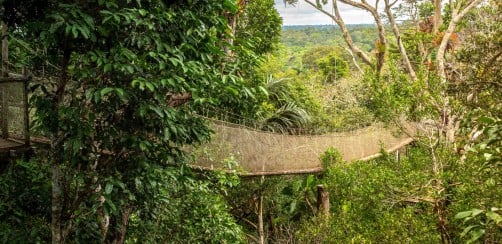A recent study conducted by researchers from Binghamton University sheds light on how arboreal animals in the Amazon rainforest are utilizing human-made canopy walkways. The research, published in the journal Neotropical Biology and Conservation, marks the first detailed investigation into the interaction between these species and artificial structures designed for forest exploration.
The study was led by environmental studies alumnus Justin Santiago, who is currently pursuing a master’s degree at Miami University, alongside Lindsey Swierk, Assistant Professor of Biological Sciences at Binghamton University. Their research was carried out at the Amazon Conservatory for Tropical Studies (ACTS) Field Station, located approximately 40 miles from Iquitos, Peru.
Canopy Walkways: Natural Highways for Arboreal Species
Canopy walkways serve as vital pathways that connect trees, enabling tree-dwelling animals to traverse their habitat without descending to the forest floor. These bridges can be either naturally occurring or artificially constructed, mimicking tree limbs extending from one tree to another. The ACTS Field Station features a series of platforms and bridges positioned between 6 to 36 meters above the ground, primarily designed for researchers and visitors.
According to the World Wildlife Fund, the Amazon rainforest is home to 427 mammal species, with around 227 of these spending significant time in the trees. The researchers installed four camera traps to monitor animal activity on the walkway over a three-week period. Their findings revealed that arboreal mammals utilized the bridge on 41 occasions, including species such as sloths, porcupines, opossums, and monkeys.
Interestingly, the majority of these animals were recorded using the walkway exclusively at night. While some species are naturally nocturnal, the timing suggests a potential adaptation to human presence, as the walkway is also frequented by tourists. Notably, during a period of minimal human activity, a sloth and a group of saki monkeys were spotted using the structure during daylight hours.
Implications for Conservation and Future Research
Santiago emphasized that arboreal mammals are typically shy and blend well into their environments, but their nocturnal behavior allows for increased mobility. This unique study opens avenues for further research, including seasonal variations in canopy usage and potential shifts in species populations.
The implications of this research extend beyond mere observation. As forest habitats continue to face fragmentation due to human activities, artificial canopy structures like walkways can provide critical pathways for wildlife. “As fragmentation continues to disconnect ecosystems, artificial canopy structures provide a safer route for arboreal species, keeping them away from roads where mortality events could occur,” Santiago stated.
The study not only enhances our understanding of how wildlife interacts with human-made structures but also contributes invaluable insights for future conservation efforts. By designing walkways that facilitate safe passage for forest creatures, researchers can help mitigate the impacts of habitat loss and promote biodiversity.
Binghamton University, recognized as the number one public university in New York, continues to lead innovative research efforts that address pressing environmental challenges. With nearly 18,000 students and over 150,000 alumni globally, the university remains committed to academic excellence and impactful research that benefits both local and global communities.







